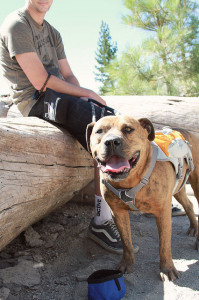One of the best parts of the summer is taking a hike with your dog. However fun can quickly turn into tragedy if you are not smart about your hiking trips. It’s easy to want to just get up and go, but taking a few moments to plan and make sure you have the right items with you can mean the difference between life and death should something go wrong.
What to Bring
Before dashing off, take a minute to make sure you are prepared. Do not just think about how long you want to be out, instead make sure you have what you need should something happen

- Cell phone, fully charged. If you hike where cell phones don’t get service, look into GPS systems and see if one of them covers the area you hike.
- Nutritious food. Don’t bring Twinkies; take something that can sustain you AND your dog if something happens. Dog-safe protein bars (sans chocolate!), dried fruit, high-protein nuts mixes, etc.
- Liquids. Bring PLENTY of water for you and your dog as well as electrolyte drinks for you. Do not bring soda or drinks high in sodium.
- Map and compass. Yup, an old fashioned map of the area. That phone is useless if it dies, gets damaged, or is out of range.
- Warm jacket, pants, and a blanket. It may be 100 degrees out during the day, but if you get lost and are outside at night, the temperature can drop fast and low. Carrying a change of clothes is always a good idea.
- Watch. Again, if that cellphone dies, you may want to know how long you have been out.
- First aid kit including any medicines you or your dog have to take (even if they are not “due” while you are out, if you get stuck you may need them).
- Rope
- Flashlight, light up dog collar or Puplights work great
- Utility knife
- Identification on both you and your dog
- Survival guide for your area including edible plant identification, etc.
- Extra leash and collar in case something breaks
Safety Tips
Tell people where you and your dog are going and when you expect to be back. DO NOT CHANGE YOUR MIND AND GO SOMEWHERE ELSE WITHOUT TELLING SOMEONE.
- Keep to the trails
- Go with someone; safety in numbers
- Be aware of the time of year and what wild animals (cougars, rattlesnakes, bears, etc) may be in your area
- Pay attention to your surroundings – make note of odd trees or other geographic markers you can use in the event you get lost
- Keep your dog on leash. If your dog wanders, you may be forced to follow them. Watching for your dog instead of paying attention to where you are going is how you get lost.
If Tragedy Strikes…
- DON’T PANIC. First, check and see if you have cell service.
- Assess your situation – is you or your dog injured? Take care of any injuries, life-threatening situations first
- Assess your food and water. How long can you survive on what you do have? Ration it out. Is there a body of water nearby you can safely get to?
- Move to shelter or water, then stay put. It is always best to stay put!
- Keep your dog with you. While sometimes you hear stories of dogs leaving their owners, finding help, and then finding their owner, this is not always the case. If you let your dog loose, he may get eaten, injured, or even more lost. Having your dog with you gives the Search and Rescue people more “scent” to follow, and your dog can make noise when things approach, alerting you and hopefully scaring off, any dangerous wildlife.
- Keep warm and dry. Snuggle with your dog and put on your change of clothes if the temperatures drop.
- Conserve energy. Do not do any needless moving around. The more energy you expend the more nutrients and water your body will need. Conserve your limited resources by limiting activity.
About the Author
Based in Wilsonville, Ore., animal lover Kristina N. Lotz is a Certified Professional Dog Trainer – Knowledge Assessed (CPDT-KA) and works as a full time trainer. She also owns her own custom pet products company, A Fairytail House, where she makes personalized collars, leashes, beds, keepsake pillows and blankets, and anything else your imagine can think up. In her spare time, she trains and competes in herding, agility, obedience, rally, and conformation with her Shetland Sheepdogs. She smartly married a Veterinary Technician, who helps keep the fur kids happy and healthy, and provides a quick resource for articles.

